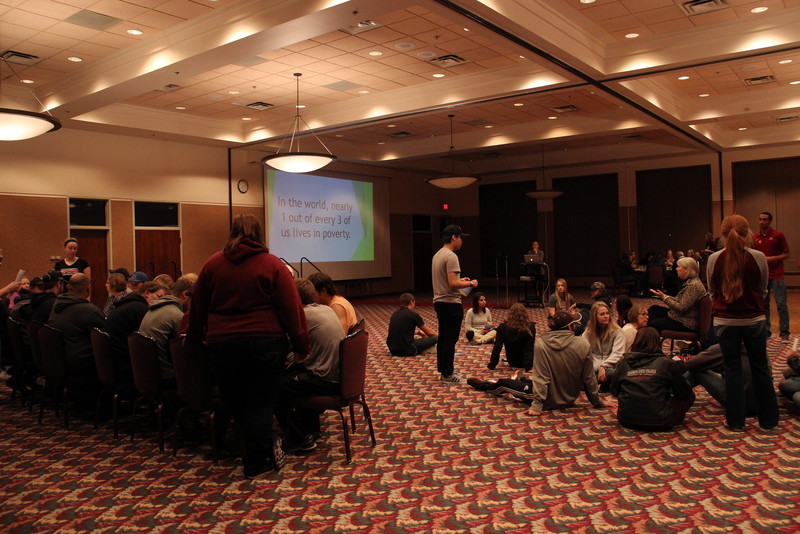Oxfam banquets bring food insecurity to life

CHADRON – When food is piled high on the Thanksgiving tables of faculty, staff and students who attended the Oxfam Hunger Banquets Monday, they may pause to consider the moment. If so, the intention of Dr. Shaunda French’s Communication Arts 239 (CA239) students will have been met, in part.
The students hosted the event, a civic engagement requirement for the class, to increase awareness about millions of people in the world who suffer from hunger or food insecurity, not knowing when one will eat next.
Those who participated in the events at 5 and 7 p.m. were given a card with a short bio describing the person they were representing and a socio-economic standing of high, medium or low class, reflecting the proportions of the world’s population at each level.
It quickly became evident the majority were low class, sitting on the floor in the center of the room. About 20 people role played middle class individuals seated at bare tables along the wall. Finally, 10 high class individuals were at a single dining table complete with multiple courses of food and linen napkins and servers.
The annual income ranges for the three groups were under $1,000 and under, $1,000-$6,000 and over $6,000.
The meal was rice and water for the low class, rice, beans and water for the middle class, and a full meal for the high class.
Pastor Ann Sundberg of Immanuel Lutheran Church, keynote speaker, said about 13 percent of Nebraska residents experience food insecurity and the percentage is higher in Dawes County.
“Nearly half of Chadron’s school children qualify for free or reduced lunch,” she said.
Sundberg added that college students, senior citizens, those who’ve lost jobs, have high medical bills, experienced a death in the family, divorce or domestic violence can also become food insecure.
She reviewed food pantry options in Chadron, including a backpack program used to send food home with children for the weekends and thanked the banquet participants for attending the “metaphor for the inequality of the world.”
Robert Ricks of Douglas, Wyoming, said his low class dining experience was eye-opening.
“It was pretty cool being a part of this experiment and to show how many people are affected by poverty and hunger. I think everybody should have to go through this experience to actually open their eyes,” he said.
Dr. Yvonne Moody, Family and Consumer Sciences professor, agreed the evening was a valuable and thought-provoking exercise.
“A simulation like this really does bring the point home in a visual way so that we can truly feel that set of extremes from one side to the other and imagine ourselves in a different situation,” she said.
In addition to increasing awareness about hunger issues, CA239 class members invited participants to do something about the problem by joining Oxfam or volunteering at a soup kitchen or food pantry. Banquet participants donated more than 300 items to the food pantry at the Immanuel Lutheran Church.
Category: Campus Events, Campus News
